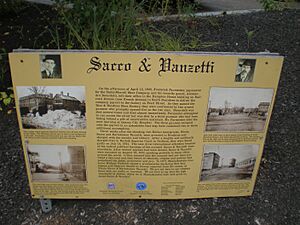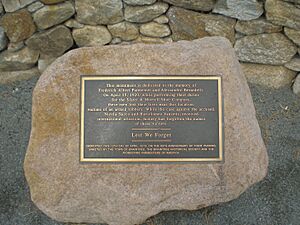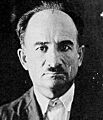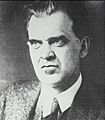Sacco and Vanzetti facts for kids
Nicola Sacco (born April 22, 1891) and Bartolomeo Vanzetti (born June 11, 1888) were Italian immigrants living in the United States. They were also anarchists, which means they believed in a society without government. In 1920, they were accused of a serious crime: robbing the Slater and Morrill Shoe Company in Braintree, Massachusetts, and killing two men, a guard named Alessandro Berardelli and a paymaster named Frederick Parmenter. Seven years later, in 1927, they were put to death at Charlestown State Prison.
After a short discussion, the jury found Sacco and Vanzetti guilty on July 14, 1921. The judge then sentenced them to death. Many people believed that the verdict was unfair because of strong feelings against Italian immigrants and anarchists at the time. This case became very famous around the world.
Contents
The Trial and Appeals
After Sacco and Vanzetti were found guilty, their supporters worked hard to appeal the decision. An appeal is when you ask a higher court to review a case because you think there was a mistake. The Sacco and Vanzetti Defense Committee helped raise money for these appeals. They argued that new evidence showed the men might be innocent. This evidence included people changing their stories, confusing information about the bullets used, and a confession from someone else who claimed to be involved in the robbery.
However, the trial judge, Webster Thayer, denied all their appeals. The highest court in Massachusetts also said no to their requests for a new trial. By 1926, the case was known worldwide. Many people started to believe Sacco and Vanzetti were innocent. This made their case one of the biggest "causes célèbres" (famous cases that attract a lot of public attention) in modern history.
Worldwide Protests and Support
In 1927, people protested in support of Sacco and Vanzetti in major cities across North America and Europe. Protests also happened in places like Tokyo, Sydney, and São Paulo. Famous writers, artists, and professors asked for the men to be pardoned or given a new trial. Felix Frankfurter, a Harvard law professor who later became a Supreme Court justice, wrote an article arguing they were innocent. Even Benito Mussolini, the leader of Italy at the time, believed they were innocent and tried to help them.
Sacco and Vanzetti were scheduled to be put to death in April 1927. This news caused even more protests. The governor of Massachusetts, Alvan T. Fuller, received many messages asking him to pardon them. He then created a special group of three men to look into the case again. This group met in secret for weeks, talking to the judge, lawyers, and witnesses. But in the end, they agreed with the original verdict. Sacco and Vanzetti were put to death on August 23, 1927.
After the Executions
Even after Sacco and Vanzetti were put to death, investigations into their case continued for many years. Their letters were published, and in these letters, they strongly said they were innocent. This made many people believe even more that they had been wrongly put to death.
Fifty years later, on August 23, 1977, the governor of Massachusetts, Michael Dukakis, made an official statement. He said that Sacco and Vanzetti had been unfairly tried and found guilty. He also said that "any disgrace should be forever removed from their names." This meant that the state officially recognized the unfairness of their trial.
Memorials and Tributes
Many tributes and memorials have been created to remember Sacco and Vanzetti and to highlight the importance of fair trials.
A famous sculptor named Gutzon Borglum, who created Mount Rushmore, made a plaster sculpture in 1937 to honor Sacco and Vanzetti. For many years, people tried to get this sculpture displayed in Massachusetts, but they were not successful. Finally, on August 23, 1997, which was 70 years after the executions, the Mayor of Boston, Thomas Menino, and the Governor of Massachusetts, Paul Cellucci, unveiled the sculpture. It is now on display at the Boston Public Library.
Mayor Menino said that accepting the artwork was not about deciding if Sacco and Vanzetti were guilty or innocent. Instead, it was meant to remind everyone about the dangers of unfair justice and the right we all have to a fair trial. This event led to new discussions in newspapers about whether the trial was fair.
There is also a large mosaic mural showing the Sacco and Vanzetti trial at Syracuse University. In Braintree, Massachusetts, where the robbery happened, there is a memorial with a poster about the crime and a metal plaque honoring the victims.
Sacco and Vanzetti's names are also remembered in other ways around the world. An American anarchist military group that fought in the Spanish Civil War was called the "Sacco and Vanzetti Centuria." In the former USSR, many places were named after them. There was even a popular brand of Russian pencils called 'Sacco and Vanzetti' for many years. Many towns in Italy have streets named after Sacco and Vanzetti, including their hometowns. There is even a small village in Eastern Ukraine called Sakko i Vantsetti.
In 2017, a plaque was placed outside the Norfolk Superior Court to remember the trial. The original records of the trial, which include everything that was said, are now kept at the Dedham Museum and Archive.
Images for kids
See also
- Edward Holton James















